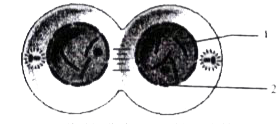After mitosis, the number of chromosomes in the daughter cells shall be
One fourth of parent cell
One half of parent cell
Twice of the parent cell
Same as the parent cell
The correct Answer is:D
Step-by-Step Solution:
1. Understanding Mitosis: Mitosis is a type of cell division that results in two daughter cells, each having the same number of chromosomes as the parent cell. It is often referred to as equational division because the chromosome number remains constant.
2. Phases of Mitosis: Mitosis consists of several phases:
- Prophase: Chromosomes condense and become visible.
- Metaphase: Chromosomes align at the cell's equatorial plane.
- Anaphase: Sister chromatids are pulled apart to opposite poles of the cell.
- Telophase: The cell prepares to divide, and the chromosomes de-condense.
3. Chromosome Count After Mitosis: At the end of mitosis, each daughter cell will have the same number of chromosomes as the original parent cell. This means if the parent cell had 'n' chromosomes, each daughter cell will also have 'n' chromosomes.
4. Evaluating the Options:
- Option A: 1/4th of the parent cell - Incorrect.
- Option B: 1/2 of the parent cell - Incorrect (this is true for meiosis).
- Option C: Twice of the parent cell - Incorrect.
- Option D: Same as the parent cell - Correct.
5. Conclusion: Therefore, after mitosis, the number of chromosomes in the daughter cells shall be the same as that of the parent cell.
Final Answer: The number of chromosomes in the daughter cells after mitosis is the same as that of the parent cell.
---
- Prophase: Chromosomes condense and become visible.
- Metaphase: Chromosomes align at the cell's equatorial plane.
- Anaphase: Sister chromatids are pulled apart to opposite poles of the cell.
- Telophase: The cell prepares to divide, and the chromosomes de-condense.
- Option A: 1/4th of the parent cell - Incorrect.
- Option B: 1/2 of the parent cell - Incorrect (this is true for meiosis).
- Option C: Twice of the parent cell - Incorrect.
- Option D: Same as the parent cell - Correct.
Topper's Solved these Questions
- CELL CYCLE (CELL DIVISION)BOOK - DINESH PUBLICATION ENGLISHCHAPTER - CELL CYCLE (CELL DIVISION)EXERCISE - REVISION QUESTIONS
267 Videos
- CELL CYCLE (CELL DIVISION)BOOK - DINESH PUBLICATION ENGLISHCHAPTER - CELL CYCLE (CELL DIVISION)EXERCISE - CHECK YOUR GRASP
18 Videos
- BIOLOGICAL CLASSIFICATION BOOK - DINESH PUBLICATION ENGLISHCHAPTER - BIOLOGICAL CLASSIFICATION EXERCISE - CYC
13 Videos
- CHEMICAL COORDINATION AND REGULATIONBOOK - DINESH PUBLICATION ENGLISHCHAPTER - CHEMICAL COORDINATION AND REGULATIONEXERCISE - Brain Teasers-V
114 Videos
Similar Questions
Knowledge Check
If a parent cell has 18 chromosomes prior to mitosis, how many chromosomes will the daughter cells have ?
AAny number between nine and thirty-sixBNineCEighteenDThirty-sixIf an endosperm cell of an angiosperm contains 24 chromosomes, the number of chromosomes in each cell of the root will be
A8B4C16D24After mitosis, the chromosome number of a daughter cell is the parent cell's
Adoubled compared toBone-halfCthe same asDrerranged compared to
Assertion : Meiosis is also known as reduction division.
Reason : Meiosis reduces the number of chromosomes in daughter cells.
View SolutionStudy the diagram given below which represents a stage during the mitotic cell division and answer the questions that follow:

Which is the cell division that results in half the number of chromosomes in daughter cells?
View SolutionIf the number of bivalents are 8 in metaphase - I, what shall be the number of chromosomes in daughter cells after meiosis -I and meiosis -II respectively:-
View SolutionA: Mitosis is a equational division .
R:During mitosis the number of chromosomes is reduced to a half.
View SolutionGiven below is a diagram representing a stage during mitotic cell division.
Study it carefully and answer the questions that follow:

How will you differentiate between mitosis and meiosis on the basis of the chromosome number in the daughter cells?
View Solution
